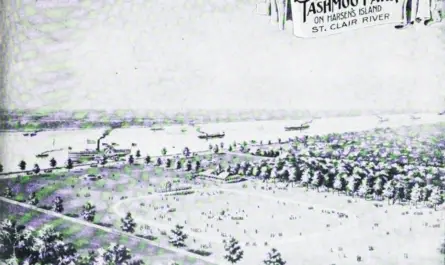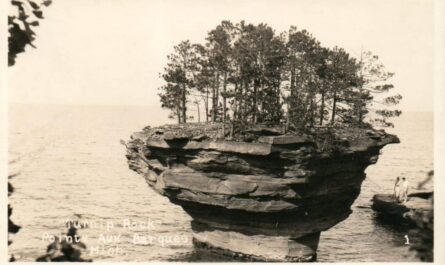Michigan’s beautiful landscape of rolling hills, sparkling lakes, and thick forests inspired early 20th-century entrepreneurs to build scenic lookout towers to entice the new generation of automobile tourists. In the 1910s and 1920s, as motoring became popular, roadside observation towers sprang up at high elevations across the state, offering panoramic views in exchange for a small admission fee.
Table of Contents
Video – Michigan’s Sky-High Tourist Towers
In the early 1900s, Michigan’s scenic highways were lined with wooden towers—built to draw in curious motorists looking for a better view. From the dueling Irish Hills Towers to the electric-elevator-equipped White Swan Tower, these once-popular attractions gave travelers a reason to stop, climb, and gaze across the Great Lakes State. This 3-minute Michigan Moments episode takes you to the top of the state’s most memorable tourist towers—and back to a time when the view was worth the stop.
Rise of Scenic Towers in the Motor Age
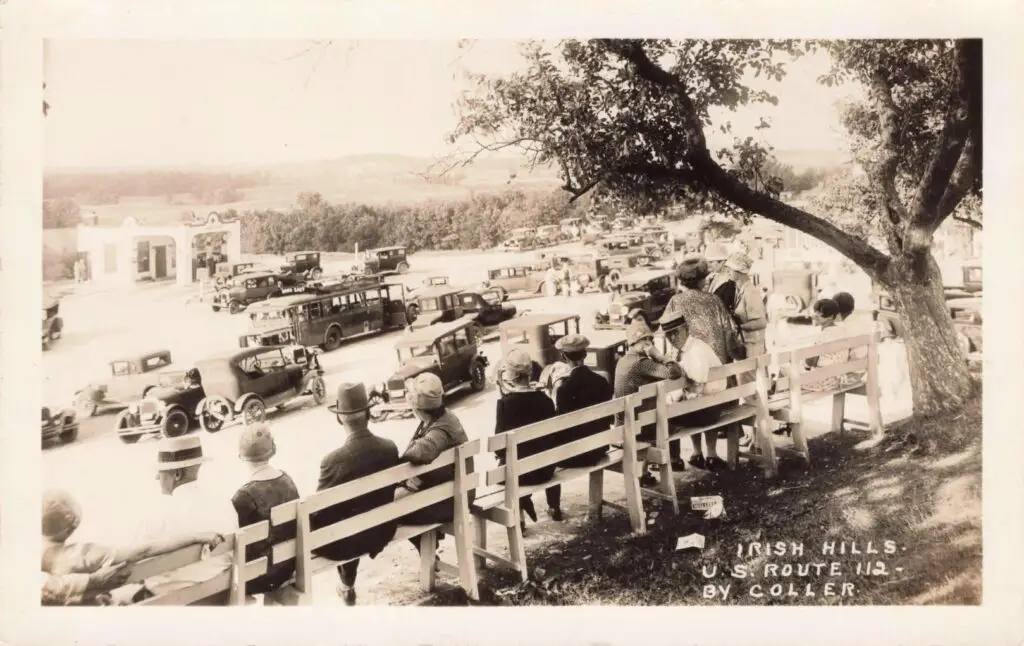
These towers were among Michigan’s first roadside attractions, complete with amenities like picnic areas, souvenir postcards, refreshments, and even electric elevators or telescopes – all designed to capture the imagination of travelers exploring by car. Visitors would climb these structures to gaze out over miles of countryside, often sending postcards of the vistas back home and creating cherished memories of Michigan’s natural beauty. Many sites became gathering places for community events and festivals, highlighting the widespread cultural appeal of climbing a tower for a bird’s-eye view in the early motor age.
One contemporary account from 1925 described over a thousand people flocking to a cherry blossom festival at a Traverse City tower, where the wooden structure was festooned with bunting, blossoms, and an American flag. Although a “chill wind whistled across the hilltop” that day, forcing many spectators to huddle in their cars, the event was still hailed as “the most impressive…ceremony ever held in the Grand Traverse region,” underscoring how beloved these lofty lookout points had become. From southern Michigan’s Irish Hills to the tip of the Lower Peninsula, tourist towers were landmarks of a bygone era – symbols of optimism, ingenuity, and the simple thrill of a panoramic view.
Twin Towers of Irish Hills (Lenawee County)
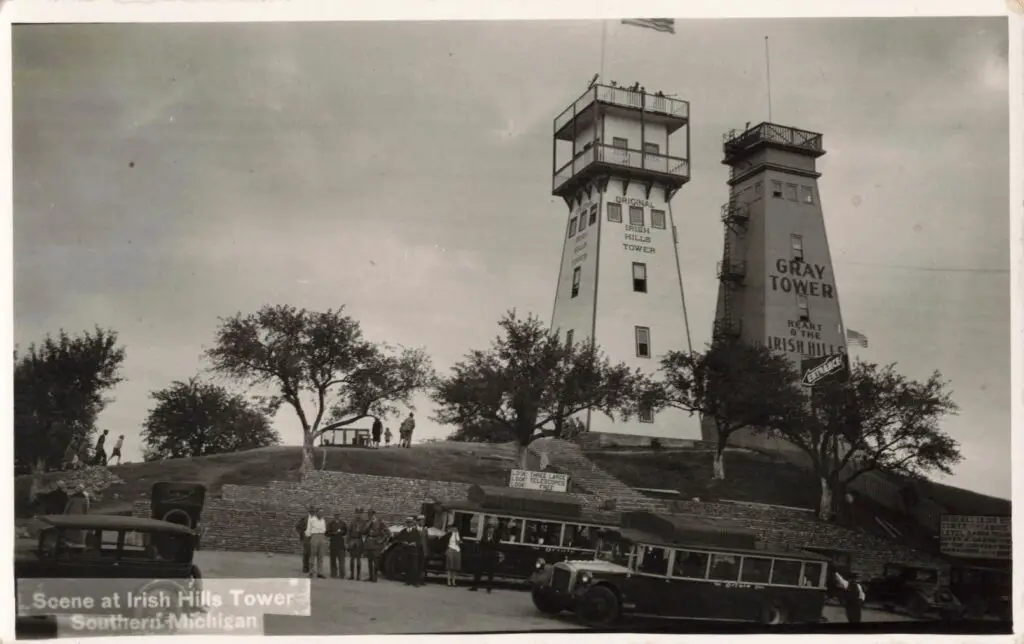
Perhaps the most iconic of Michigan’s lookout towers are the Irish Hills Towers, twin wooden observatories perched on a knoll along US-12 in Lenawee County’s Irish Hills. The first tower, the Irish Hills Observatory, was erected in late 1924 by the Michigan Observation Company (MOC). MOC had formed that year with the idea that panoramic viewing towers could be lucrative tourist attractions, and they chose this high point amid the Irish Hills lakes for a 50-foot enclosed platform. During its grand opening weekend in October 1924, hundreds of visitors climbed the new tower to admire “rolling landscape and crystal blue lakes in all directions”.
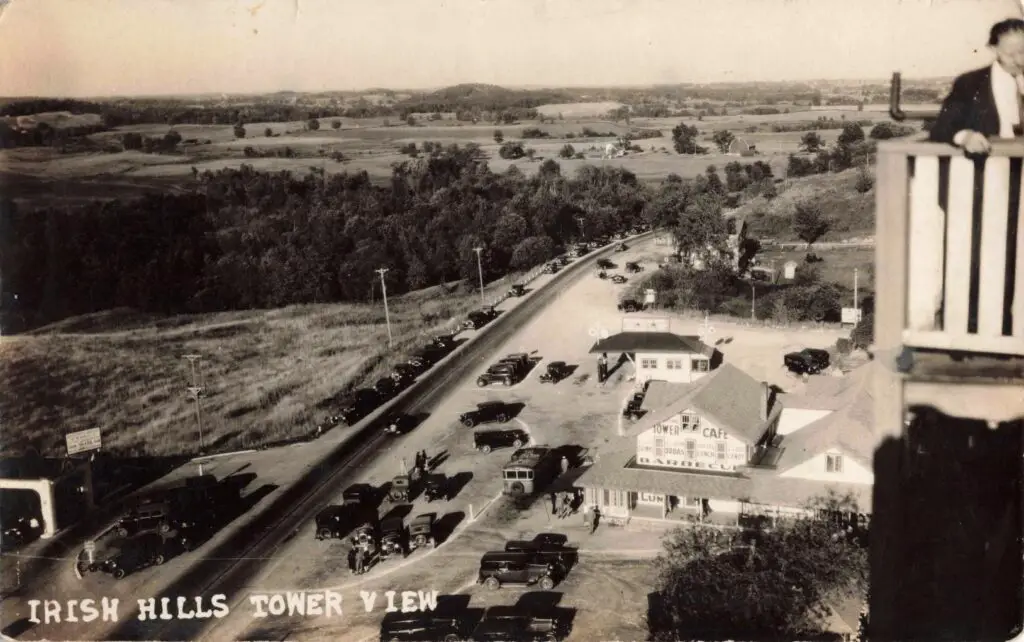
However, a property dispute and entrepreneurial rivalry gave Irish Hills its famous second tower. The neighboring landowner, Edward Kelly, angered at seeing a tower rise next door, hastily built his “Gray Tower” just a few feet away in November 1924 – deliberately making it slightly taller than the first. This tit-for-tat competition escalated: MOC added an extra observation deck to reclaim the height advantage for its “Original Irish Hills Tower,” and Kelly, in turn, raised his tower’s platform until both stood roughly equal.
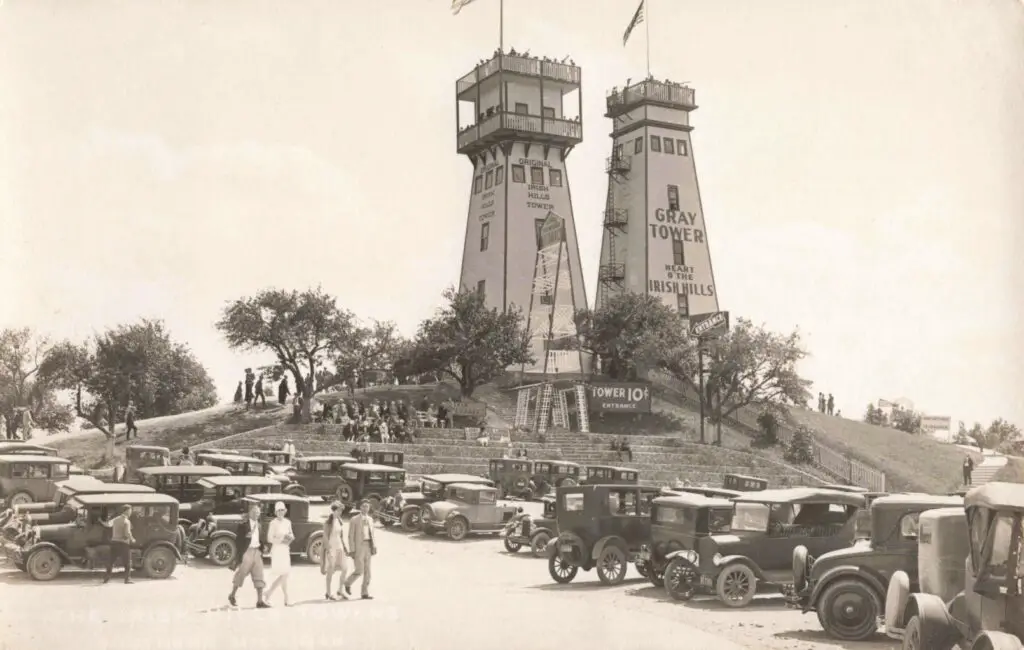
Locals nicknamed Kelly’s structure the “spite tower.” After some tense threats (MOC warned it would erect an even bigger steel tower if Kelly kept building upward), the two sides called a truce. For decades thereafter – through the 1930s and into the 1950s – the two towers operated side by side as separate, competing attractions, each charging admission to climb and enjoy the 360-degree view of the Irish Hills. Visitors could spot countless lakes and even see into the surrounding counties from the top on a clear day. Both towers sold postcards and souvenirs, and after 1955, a single owner acquired and connected them with a ground-floor gift shop.
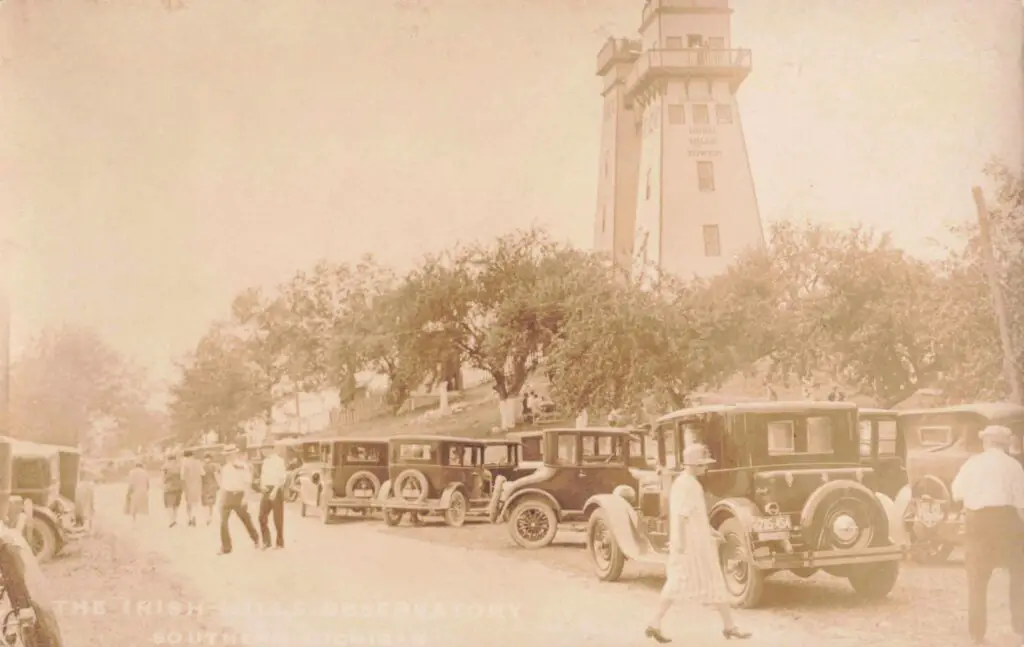
The Irish Hills Towers remained a beloved roadside stop well into the 20th century. They closed to the public in 2000, after interest waned and maintenance grew difficult. Now nearly 100 years old, the twin towers still stand but are shuttered and in need of restoration. Listed on the National Register of Historic Places, they avoided demolition through local preservation efforts, and as of 2024, they remain closed pending full repairs. The Irish Hills Historical Society has been raising funds to stabilize and refurbish the towers, hoping to reopen these storied structures as a museum or lookout once again. Even in silence, the weathered wooden towers of Irish Hills continue to loom over US-12 as nostalgic monuments to Michigan’s early tourism boom.
White Swan Electric Tower (Manitou Beach, Lenawee County)
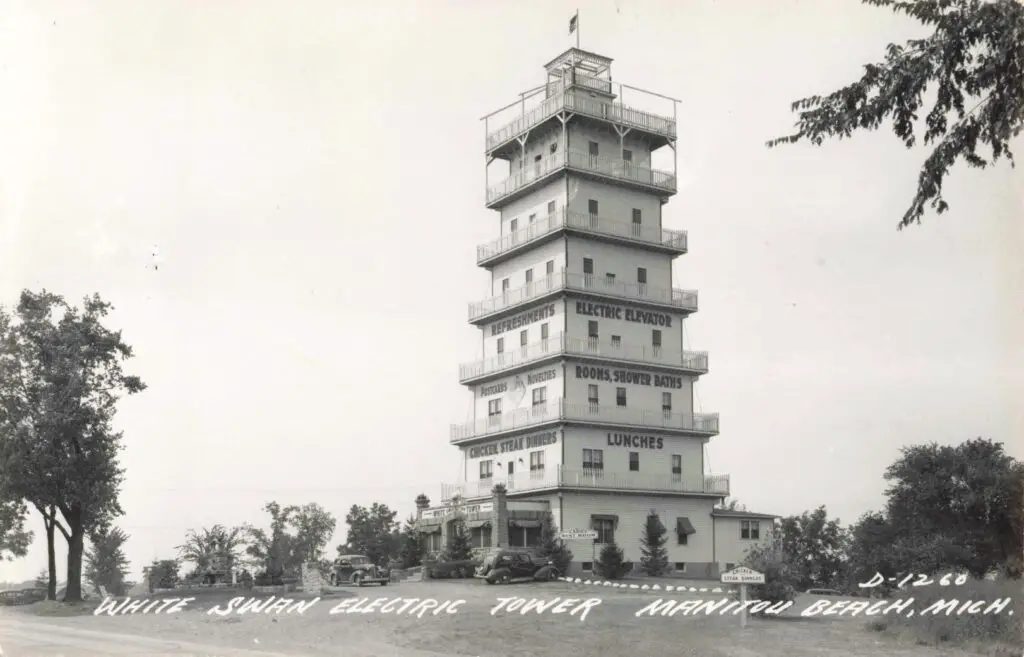
In the Irish Hills resort district, about 15 miles from the twin towers, the White Swan Electric Tower rose at Devils Lake’s Manitou Beach as another remarkable attraction of the era. Opened in 1930 on old US-223, the White Swan Tower stood about 109 feet tall and boasted an electric elevator – a rare high-tech luxury at the time for such a facility. Built opposite a popular bathing beach, this multi-story wooden tower was part of a larger amusement complex.
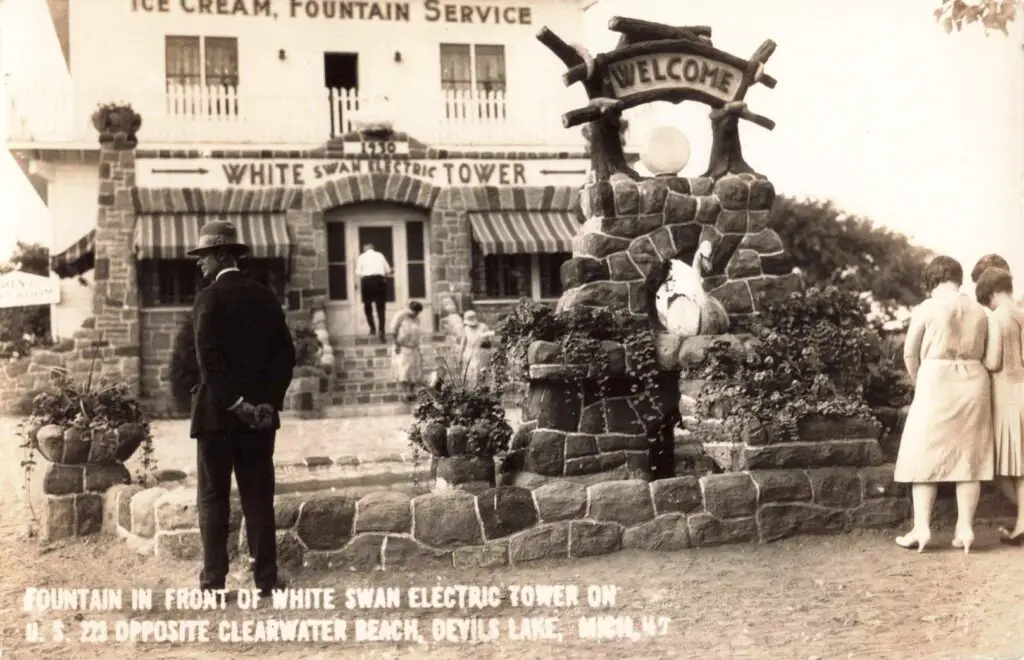
It featured a ground-floor restaurant (famous for its chicken dinners and ice-cold milk), refreshment stands, a novelty and postcard shop, and even “shower baths” for swimmers. Outside, visitors could enjoy a Cascade fountain and other amusements on the landscaped grounds. For a fee, the tower’s elevator whisked sightseers to an observation deck high above Devils Lake, from which one could gaze over the sparkling water and the surrounding countryside.
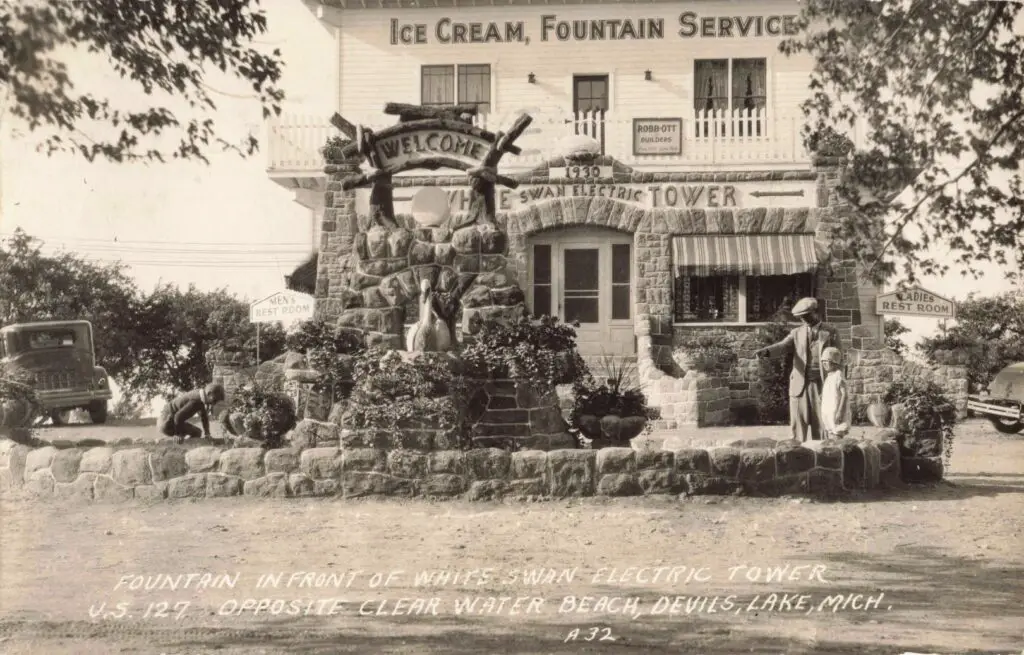
The White Swan Electric Tower quickly became a centerpiece of summertime entertainment at Devils Lake. However, like many such ventures, it struggled to remain viable during World War II and the post-war years. By the mid-1940s, the wooden structure was deteriorating – its white paint peeling from exposure – leading new owners in 1945 to remove the top five floors for safety and maintenance reasons.
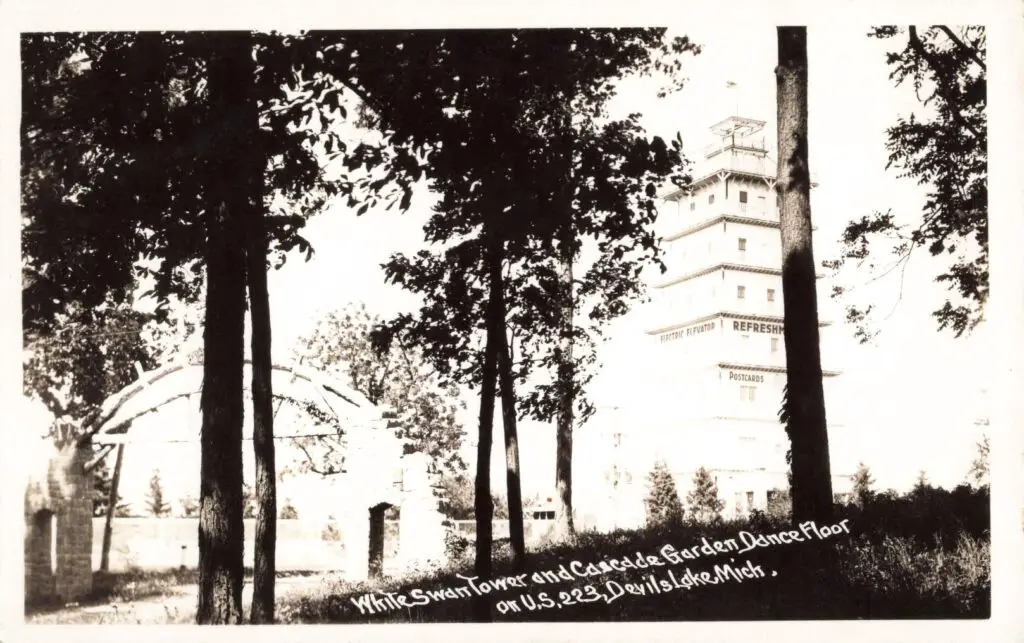
The lower levels of the tower were enclosed and converted into the White Swan Restaurant and Tavern, allowing the business to continue on a smaller scale. The once-towering observatory was effectively reduced to a two-story roadside inn by the early 1950s. The remaining stump of the tower operated under various names (it was known as the “Lighthouse Inn” in its later years) until it finally closed in the late 1990s. All remnants of the White Swan Tower were demolished in November 2001, and today the site has been absorbed into a golf course parking lot. The only evidence of its existence lies in vintage postcards and fond recollections of an era when an elevator ride to a lofty lakeview was the height of tourist novelty.
Bundy Hill Observation Tower (Hillsdale County)
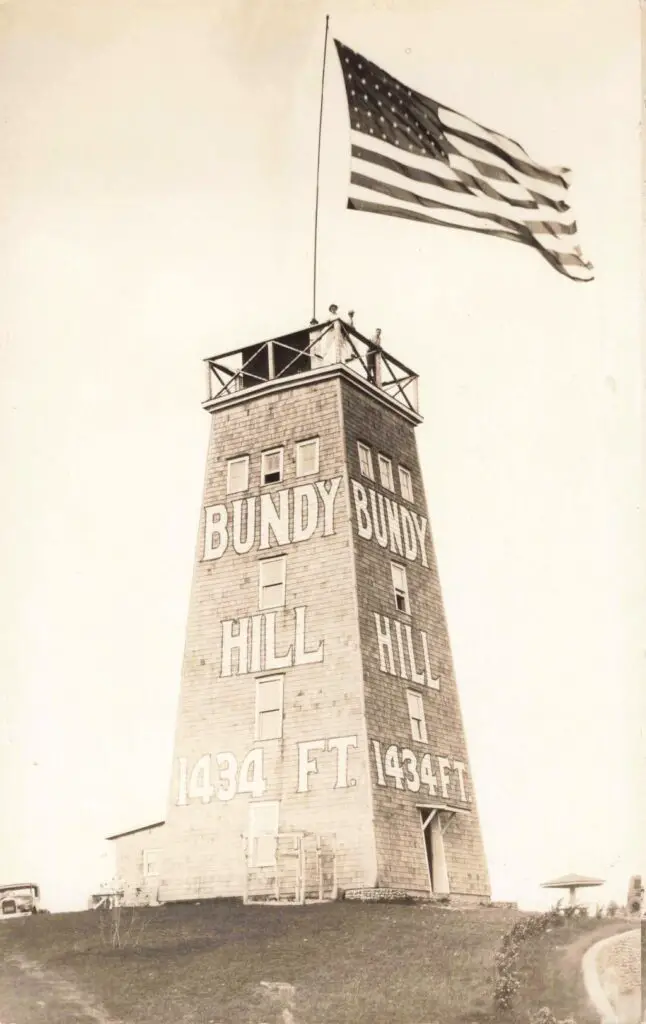
Not far from the Irish Hills, another early tower rose atop Bundy Hill, the highest point in southern Michigan (elev. 1,270+ feet). The Michigan Observation Company built the Bundy Hill Tower in 1924, just weeks before completing the first Irish Hills Tower. Located near Jerome on the Jackson–Hillsdale county line, this 50-foot wooden tower capitalized on Bundy Hill’s commanding view over the meeting of three counties. It was named for John Bundy, who owned the 6-acre hilltop property. Tourists driving the historic Chicago Road (US-12) would stop to climb the tower’s stairs and survey the patchwork of farms, forests, and lakes spreading out below.
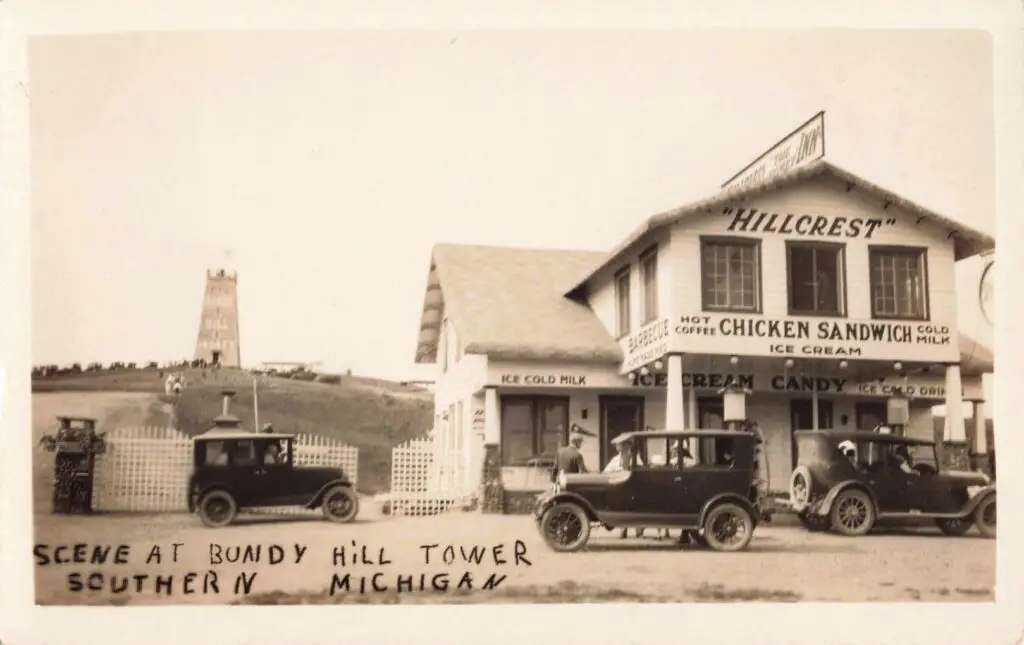
In the late 1920s, Bundy Hill became a mini destination of its own. New owner John Rainey purchased the property in 1928 and expanded the attractions: he added a free campground and picnic grounds, a dance hall, a small menagerie or “zoo,” and a restaurant famous for its chicken sandwiches and cold dairy milk. An on-site establishment called Hillcrest Inn (as seen on period postcards) served hot coffee, lunches, and pie to hungry travelers. Brightly painted signs proclaimed Bundy Hill the “top of Michigan’s lower peninsula” and invited motorists to pause for a panorama and some refreshment.
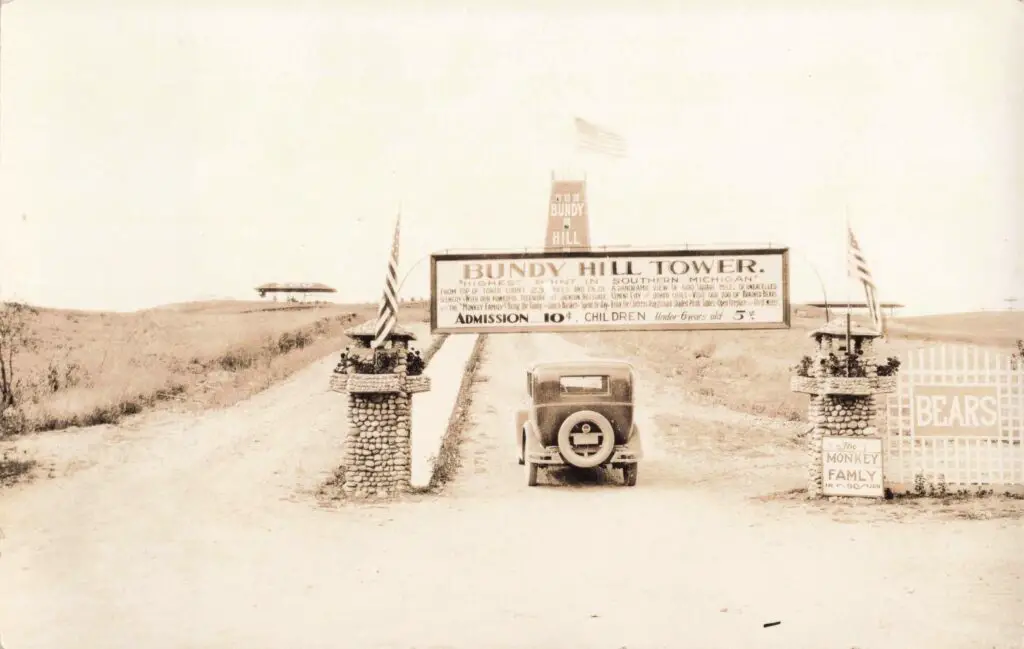
By the post-war era, however, Bundy Hill’s heyday waned. With highway traffic declining on old US-12 (replaced by newer routes) and the wooden tower aging, the site was repurposed. In 1949, new owners dismantled the observation tower and even reused its sturdy timbers to construct a roadside eatery called the Bundy Hill Diner. Today, nothing remains of the original tower – the summit is quiet woodland – but its legacy lives on in local lore as a high point of early Michigan motor tourism.
Bettes Tower (Sparta, Kent County)
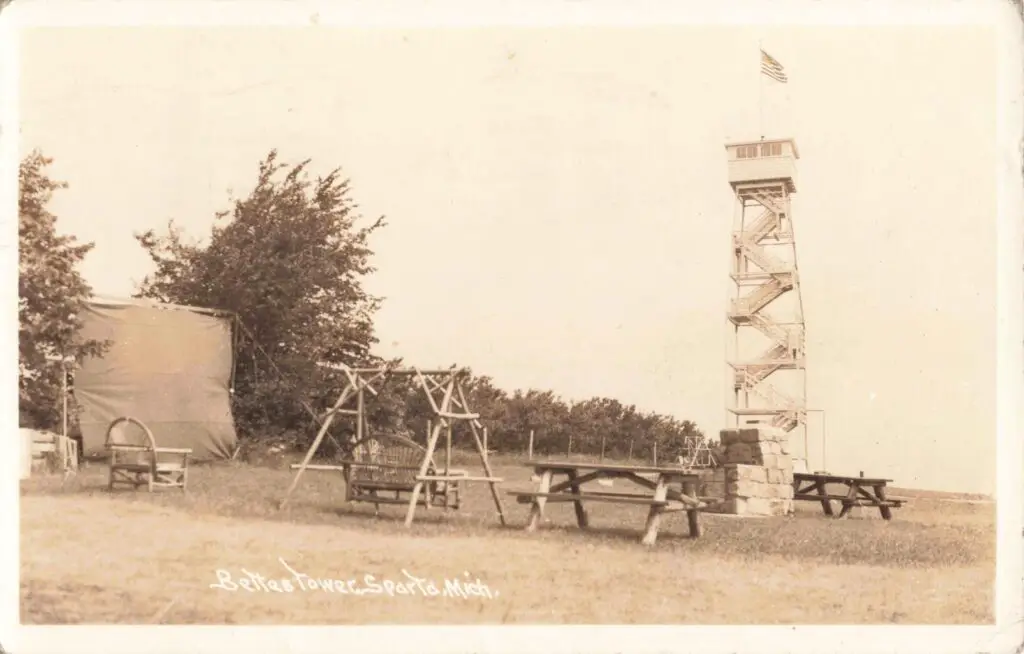
In western Michigan, the town of Sparta once boasted its own tourist lookout known as Bettes Tower. This rustic wooden tower was built in the 1920s by George W. Bettes, a local inventor, aviator, and entrepreneur, on a hill just west of Sparta’s village center. Bettes constructed the tower on his property (nicknamed Bettes Tower Hill) to share the sweeping view of apple orchards, farms and the Grand River valley with visitors. The multi-level structure had an open framework and a flag flying from its peak, as visible in surviving photographs. Families driving the country roads on Sundays would stop to climb Bettes Tower and picnic on the grounds below. There was no major highway here – unlike the Irish Hills towers – so this attraction remained more of a regional novelty and community point of pride.
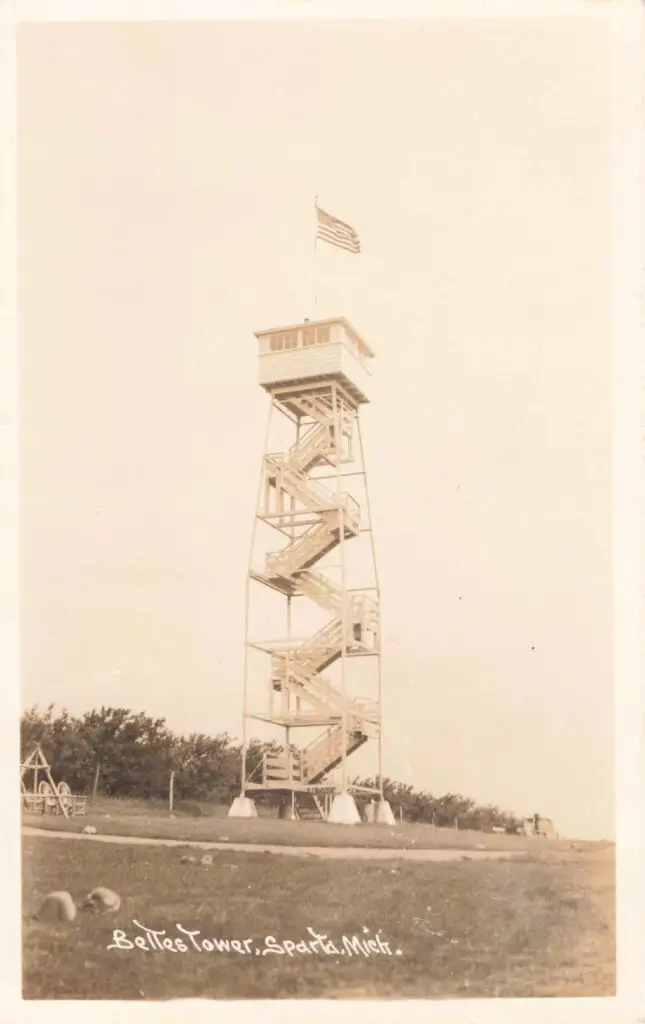
George Bettes maintained his tower for many years, and it became a beloved local landmark. Remarkably, by the 1960s, the old tower even found a new use: Sparta’s civil defense volunteers utilized Bettes Tower as a tornado watch post, stationing lookouts atop it during severe weather to scan for funnel clouds across the flat countryside. By the late 1970s, however, time had caught up with the structure. The wooden tower was deemed unsafe and was finally torn down in the late 1970s after roughly half a century standing guard over Sparta. Although little documentation of Bettes Tower survives, older residents still recall the era when a climb up “Sparta’s tower” offered a taste of adventure and a panoramic reward.
YMCA Camp Nissokone Tower (Oscoda, Iosco County)
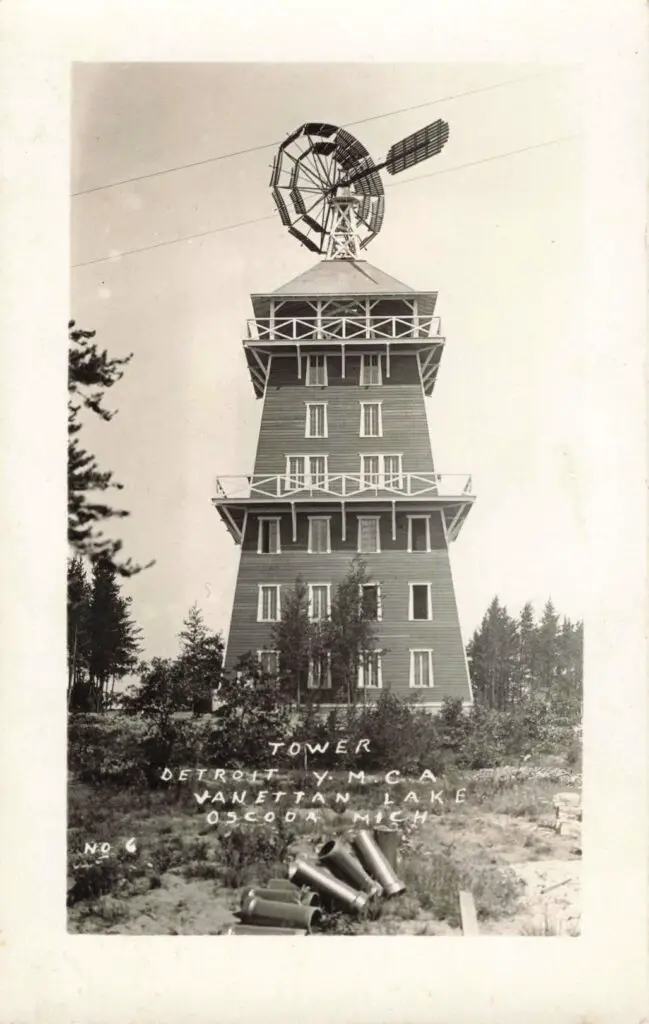
.
Not all Michigan observation towers were commercial roadside enterprises – one notable example stood at Camp Nissokone, the Detroit YMCA’s summer camp on Van Ettan Lake near Oscoda. Built in the 1920s or early 1930s, the Camp Nissokone Tower was a tall, timber-framed lookout rising above the camp’s cabins and pines. It doubled as both a scenic outlook and a functional camp structure: historical photos show a windmill or water-tank apparatus mounted at the tower’s peak, indicating it may have helped pump water or generate electricity for the camp.
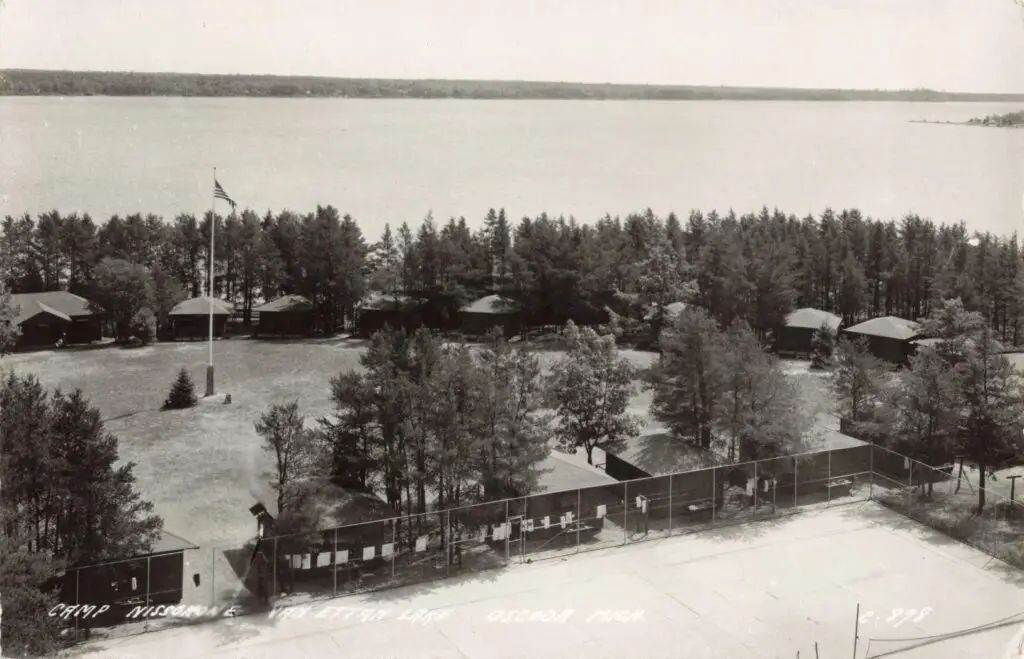
More importantly for generations of boys (and later girls) who attended Camp Nissokone, the tower was a source of adventure and inspiration. Campers could ascend the tower’s laddered levels for a spectacular view of Van Ettan Lake’s blue waters and the surrounding Huron National Forest. The tower became a popular image on camp postcards and brochures, symbolizing the lofty character-building goals of the YMCA camp experience.

During World War II, the Camp Nissokone tower may have even been used for aircraft spotter duty, as northern Michigan camps and fire towers were sometimes enlisted to watch the skies. The exact fate of the tower is not well documented, but former campers recall that it stood through the 1960s and into the 1970s. By the 1980s, the venerable structure had been taken down, as modern safety standards and camp expansions made it obsolete. Today, Camp Nissokone (founded in 1914) still operates as a youth camp, but its iconic tower exists only in memories and a handful of vintage photographs. For those who climbed it, the simple thrill of surveying the wild panorama of Oscoda’s lakes and woods from on high remains an unforgettable part of Michigan’s camp history.
Old Mission Peninsula’s Golden and Friedrich Towers (Grand Traverse County)
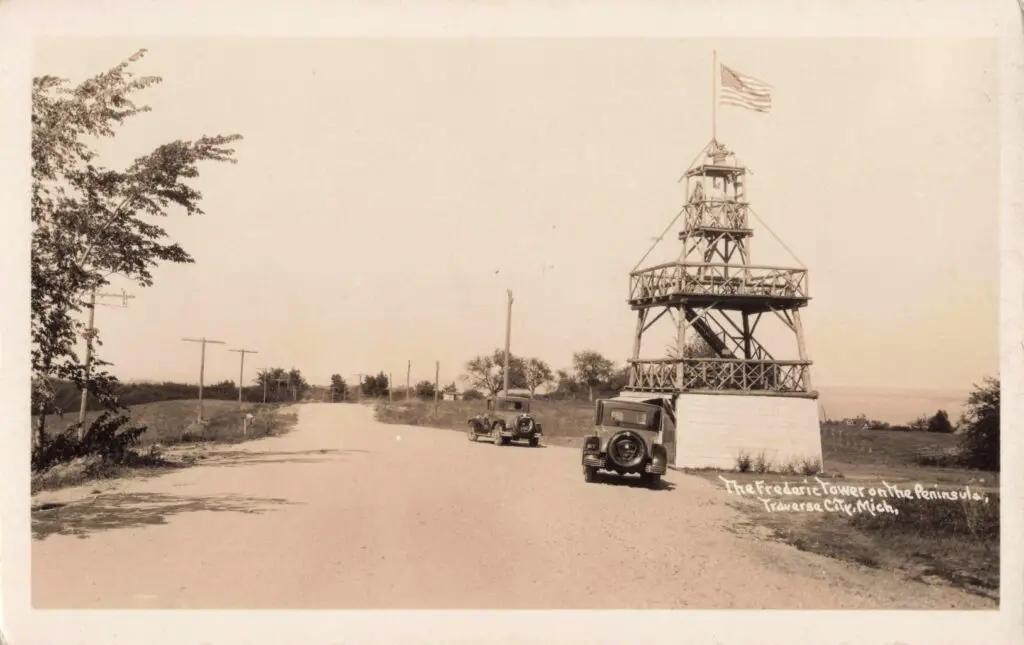
Scenic towers were not limited to southern Michigan. In the Traverse City area – at the base of Old Mission Peninsula – two unique towers appeared in the early 1920s amid the region’s famed cherry orchards. The first was Friedrich’s Tower, a free-standing log observatory built in 1920 by orchardist A.V. Friedrich on a high point along Center Road (near today’s Chateau Grand Traverse winery).
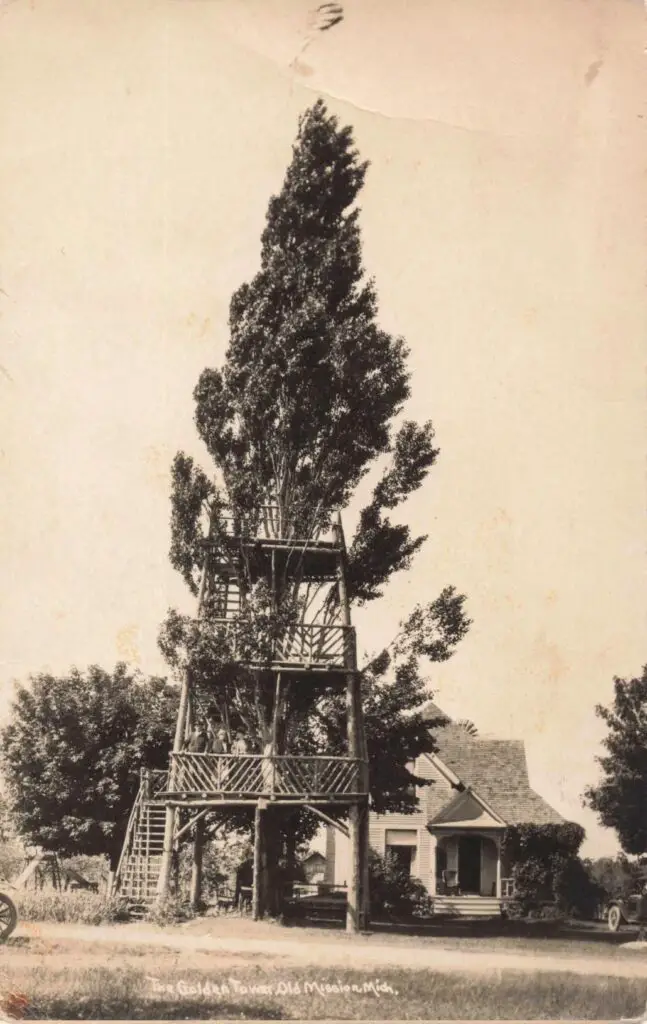
The second, constructed a few years later (circa 1924), was the Golden Tower, erected by the children of early settler Windsor Golden on their family farm off Eimen (Elmen) Road. Uniquely, the Golden Tower was built around a living poplar tree – its platforms and stairs winding up the trunk, giving a “rustic treehouse” character to the structure. Both towers stood roughly 30–40 feet high with multiple viewing decks, and both took advantage of Old Mission’s natural topography: from their summits visitors could survey thousands of blossoming cherry trees in spring, the patchwork of orchards and villages, and the twin arms of Grand Traverse Bay extending on either side of the peninsula.
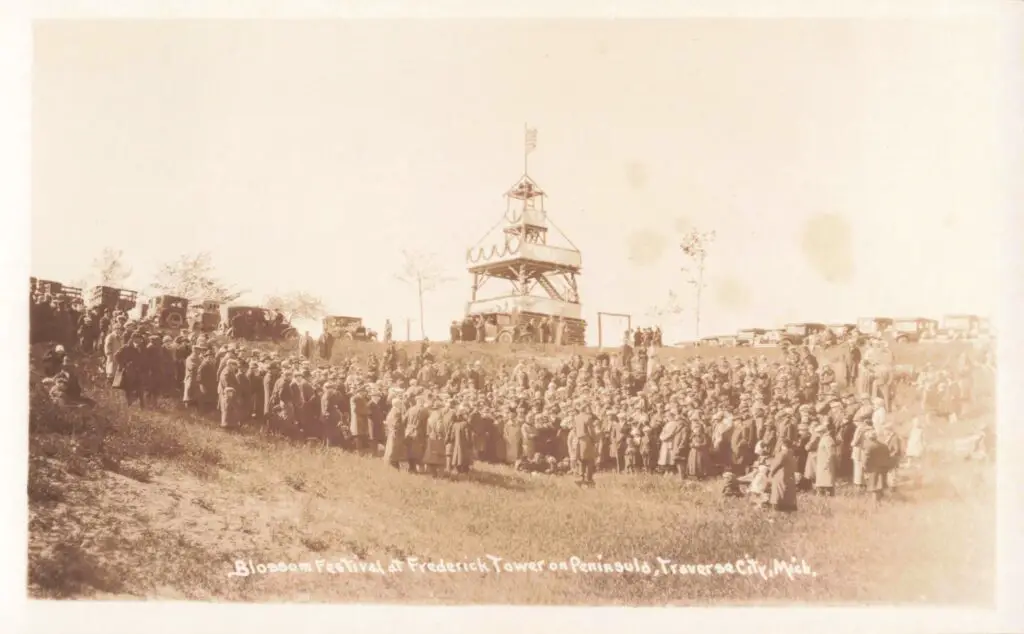
The Old Mission towers charged a modest admission and advertised in the Traverse City Record-Eagle during the 1930s to lure summertime tourists and Sunday drivers. They even played a role in local traditions – Friedrich’s Tower was the site of the first official Blessing of the Blossoms ceremony in May 1925, a predecessor of today’s National Cherry Festival. For that event, Friedrich’s tower was decorated with flags and evergreens, and a large crowd gathered (many sheltering from the cold wind in a nearby valley) to inaugurate the cherry blossom season with hymns and prayers. During World War II, both the Friedrich and Golden towers were reportedly used as watch towers for spotting aircraft, since their vantage points were strategically useful on the home front.
By the late 1940s, these wooden towers had begun to disappear. The exact dates are unclear, but it appears the Golden Tower was dismantled or fell into disrepair shortly after WWII (the 1950s no longer advertised it). Friedrich’s Tower likely survived a bit longer for occasional use by locals – oral histories note it standing into the early 1950s before being removed. Today, no trace remains of either Old Mission Peninsula tower on its respective sites; the land has been redeveloped (vineyards, private property), and trees now obscure the once-open views. Yet these towers live on in local memory as charming relics of a simpler time – when an old poplar tree or a stack of logs on “Winery Hill” could be transformed into a magical lookout, delighting tourists and residents alike with the unparalleled vistas of Michigan’s cherry country.
Other Notable Towers and Legacy
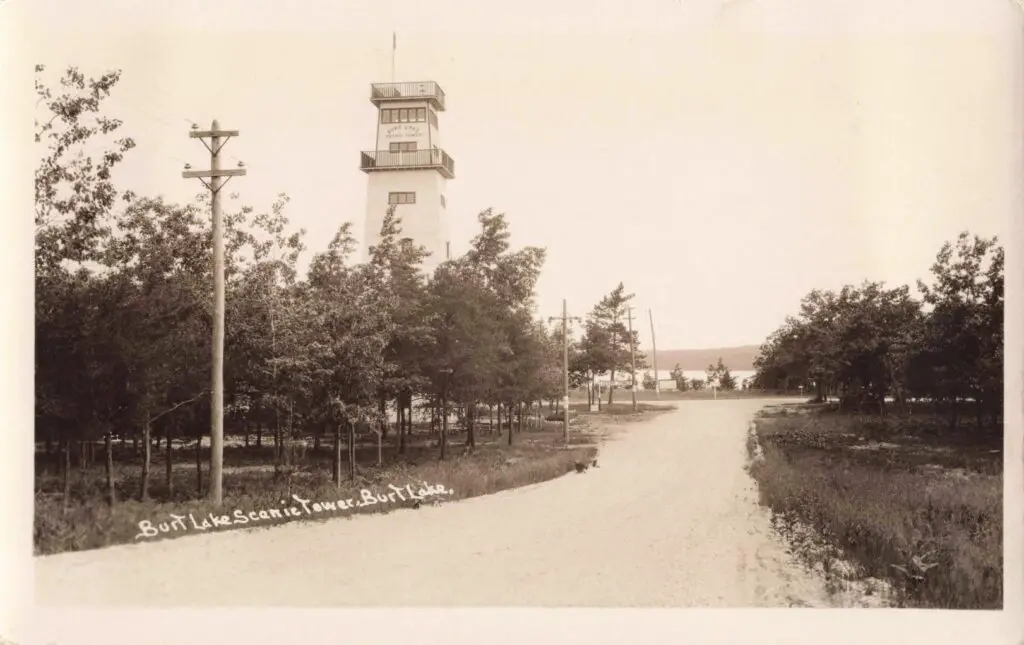
Beyond the prominent examples above, Michigan’s early tourist era saw a sprinkling of other lookout towers that have since faded into history. In the northern Lower Peninsula, for instance, the Burt Lake Scenic Tower near Indian River was built in the 1920s and drew visitors with the promise of a bird’s-eye view of Burt Lake and the Inland Waterway. Uniquely, it featured a powerful Carl Zeiss 42× telescope on its observation deck for enhanced viewing – a very novel attraction at the time. Though popular through the 1930s, the Burt Lake Tower was gone by the 1960s; today, only an overgrown roadside overlook in Burt Lake State Park marks the spot where it once stood.
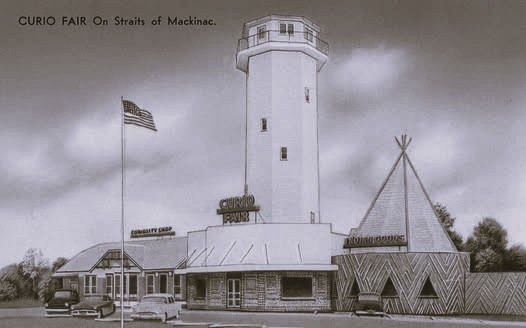
Farther north, St. Ignace briefly boasted a mid-century tower called the Curio Fair Tower (built 1955–56) that allowed tourists to watch the Mackinac Bridge being built. And in Leelanau County, a simple wooden platform nicknamed “Top of the World” gave drivers on the Glen Lake scenic route a panoramic stop-off in the 1930s.
Though each tower had its own story, they all catered to the same impulse: the human urge to climb higher and take in the grandeur of Michigan’s scenery. These lookout towers were important early fixtures of motor tourism – precursors to modern highway vistas and observation decks. They turned high points and hilltops into destinations at a time when long-distance car travel was still an adventure. Many families in the 1920s–40s fondly recalled the excitement of pulling off the road, paying a small fee (often 10 to 25 cents), and ascending a creaky staircase to emerge above the treetops and farms.
What Happened to Michigan’s Tourist Towers?
Most of Michigan’s tourist lookout towers did not survive beyond the mid-20th century. As the novelty wore off and interstate highways bypassed the old routes, attendance dwindled. Wooden structures aged and became liabilities, and nearly all were eventually demolished or collapsed. Yet their legacy endures in the state’s cultural history.
The Irish Hills Towers, for example, remain as a nostalgic landmark and are the focus of ongoing preservation efforts, while historical societies and writers continue to document the stories of others. The appeal that built them – the love of a spectacular view – is as strong as ever. Modern travelers still seek out high vantage points like observation decks, scenic overlooks, and towers (such as the late-1960s concrete Tower of History in Sault Ste. Marie) to experience Michigan’s vistas. In that way, the old wooden towers of the 1920s set a precedent: they taught generations of Michiganders that some of the best travel memories are made by simply stopping, climbing up, and taking in the endless horizon.
List – Early 20th-Century Michigan Tourist Towers
| Tower Name | Location | Built | Original Use | Current Status |
|---|---|---|---|---|
| Irish Hills Towers | Irish Hills (Cambridge Twp), Lenawee Co. | 1924 | Twin wooden observation towers; scenic views of lakes; separate tourist operations with gift shop (later connected) | Standing (closed since 2000); on NRHP; preservation in progress |
| White Swan Electric Tower | Devils Lake (Manitou Beach), Lenawee Co. | 1930 | Resort observation tower with electric elevator; included restaurant, rooms, showers, cascades & amusements | Demolished – top removed 1945, converted to tavern; final structure razed by 2001 |
| Bundy Hill Tower | Near Jerome, Hillsdale Co. (US-12) | 1924 | Observation tower on highest hill in S. Michigan; later added campground, dance hall, zoo, restaurant | Removed – tower dismantled 1949; lumber reused for diner |
| Bettes Tower | Sparta, Kent Co. | c.1924 | Local sightseeing tower built by George W. Bettes; panoramic rural views; used for picnics and later civil defense watch | Removed – became unsafe and torn down in late 1970s |
| YMCA Camp Nissokone Tower | Van Ettan Lake (Oscoda), Iosco Co. | c.1925 | Camp observation tower (Detroit YMCA); scenic lake views for campers; topped with windmill apparatus | Removed – no longer extant (taken down by late 20th century). |
| Golden Tower | Old Mission Peninsula, Grand Traverse Co. | c.1924 | Rustic log tower built around a large poplar tree; scenic views of cherry orchards and bays | Removed – dismantled post-WWII (no remains). |
| Friedrich (Frederick) Tower | Old Mission Peninsula, Grand Traverse Co. | 1920 | Free-standing timber tower by A.V. Friedrich; overlook for cherry orchards; site of festivals | Removed – standing through 1940s; later taken down (no remains). |
| Burt Lake Scenic Tower | Indian River, Cheboygan Co. | c.1920s | Lakeside observation tower; featured 42× power telescope for visitors | Removed – gone by 1960s; site now a state park overlookl |
Each of these towers, whether famous or largely forgotten, played a part in Michigan’s early tourist history. They invited travelers to pause their journey, ascend above the everyday, and share in a grand view – forging a tradition of sightseeing and exploration that continues in new forms to this day.
Sources
“Irish Hills Towers (Cambridge Township, Michigan).” National Register of Historic Places Inventory–Nomination Form, Michigan State Historic Preservation Office, 2012.
Tinder, David V. “David V. Tinder Collection of Michigan Photography.” Bentley Historical Library, University of Michigan.
“Old Mission Peninsula’s Friedrich and Golden Towers.” Old Mission Gazette, 30 Mar. 2022. .
“Lost Burt Lake Tower: Northern Michigan’s Tourist Telescope.” Lost In Michigan, 14 Aug. 2023. .
“Frederick Tower at the Blossom Festival, Traverse City.” Traverse Area District Library Archives. https://www.tadl.org (Direct link unavailable—referenced via postcard image from Tinder Collection).
Byron, M Christine. “Landscapes with a View – Michigan Blue Magazine.” Michigan Blue Magazine, Oct. 2019, . Accessed 7 Aug. 2025.


